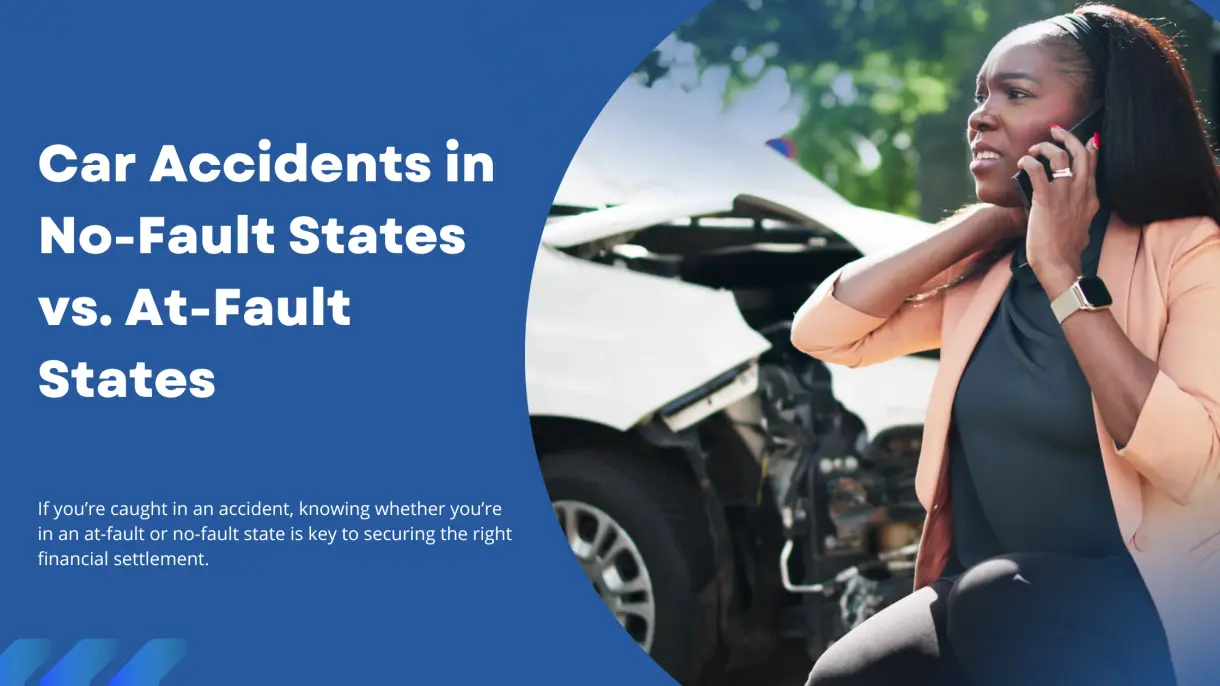People hurt in traffic accidents nationwide either live in at-fault or no-fault states. This variable determines who is responsible for paying each person’s property damage and medical expenses.
It’s helpful to understand the distinction between traffic accidents in no-fault and at-fault states — and figure out which one applies to your injury case.
Ready to see if you may qualify? Click here to get a FREE, no-obligation consultation before starting your claim.
What is an At-Fault State?
In an at-fault system, whoever was most responsible for the car accident pays for the other party’s injuries and damages.
At-fault states require you to gather evidence and potentially speak in court to prove your liability for the accident.
Depending on your case, determining the cause of your accident can be difficult or straightforward. If you’re in an at-fault state, the more evidence you have, the more solid your case can be.
How Do You Determine Fault in a Car Accident?
If you’re in an at-fault state, you’ll need a variety of evidence in and out of the accident scene. This evidence can help you establish a case for your insurance company and your attorney if you need legal representation.
Examples of evidence you’ll need for an at-fault car accident claim include:
- Pictures of the accident scene and your losses
- Medical evidence and documents of your injuries
- Witness testimonies
- Police reports summarizing the crash
Fault by nature is subjective, and insurance companies can misconstrue your case to benefit themselves and lower how much you’re owed. You may need to hire an auto accident attorney to create a solid case, especially in at-fault states.
Can Both Drivers Be At-Fault for a Collision?
Certain states work under a comparative negligence system, allowing both parties to share fault if their actions contributed to each other’s damages.
Some states limit this shared fault, where whoever was more than 50% at-fault pays for the majority of the damages.
If you’re partially at-fault for the collision, your overall settlement is reduced by your percentage of fault. If you’re 10% at-fault, your overall settlement is reduced to 90% of its original total.
What is a No-Fault State?
When traffic accidents happen in a no-fault system, your auto insurance provider automatically pays for your damages.
This happens regardless of who’s at fault, up to a specified limit. In no-fault states, drivers carry Personal Injury Protection (PIP) insurance to cover expenses incurred from traffic accidents.
One good thing about traffic accidents in no-fault states is not having to deal with anyone else’s insurance provider. If you’re driving and get into a traffic collision that injures you, PIP covers all your medical expenses and car repair costs.
These policies can be quite expensive, however. PIP policies are one reason Florida drivers generally pay more for car insurance than drivers in at-fault states do, like Wisconsin.
Can You Still Sue in a No-Fault State?
No-fault states have regulations and limits for how much you can receive from a car accident lawsuit. In most cases, these regulations prevent litigation from happening altogether.
The focus of no-fault laws is for your insurance to focus on compensating your damages, not the other party. Their own insurance will pay for their damages also.
Only if the losses you suffered were severe or life-changing can you pursue a lawsuit in a no-fault state. The damages you can receive may be limited to non-economic damages and certain types of compensation.
Will Your Insurance Rate Go Up if You’re At-Fault?
You almost always see an increased insurance rate if you’re found at-fault for a car accident. This can stay in your record for a certain amount of years depending on your state and insurer.
Even for cases where you’re not at-fault, your insurance may increase after filing an accident claim. To the insurance company, a crash may indicate further accidents in the future. Comprehensive insurance claims can affect your rates as well.
Insurance companies often give forgiveness programs that can nullify price increases under certain circumstances. Contact your insurance provider to take advantage of such programs if you qualify.
Talk with an Auto Accident Attorney to Find Your Options
If you feel you deserve damages from your car accident, understand your rights by talking with an auto accident attorney.
At-fault states allow insurance companies to get their attorneys and insurance adjusters involved in your accident settlement. To defend yourself, you may need your own attorney to settle the score.
Related: Car Accident Insurance & Injury Claim FAQs
Ready to see if you may qualify? Click here to get a FREE, no-obligation consultation before starting your claim.
Jan Reburiano is a content writer and SEO specialist for law firms focusing on personal injury, disability, employment law, among other practices. He has written and edited numerous articles and created commercial spots for broadcasters that you can find in his LinkedIn. Jan currently lives in Los Angeles, California while writing for clients from around the United States.
